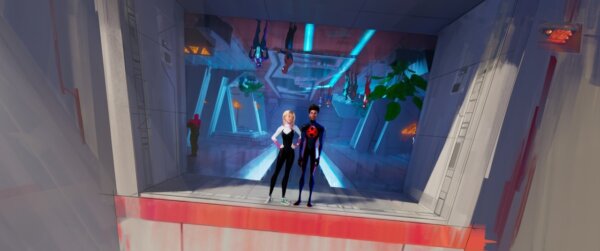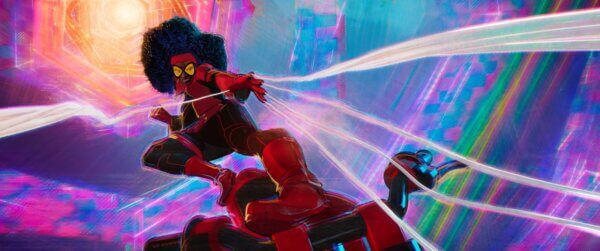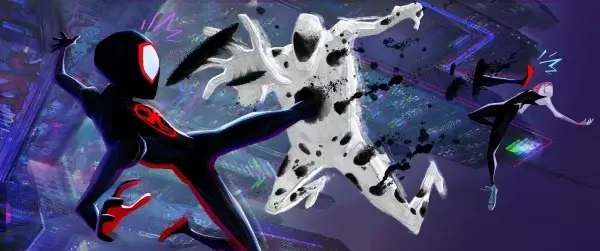Across the Spider-Verse Trailer + The Directors Speak!
As the brand new trailer for Spider-Man: Across the Spider-Verse is launched to an excited public, we’re delighted to shed more light on the forthcoming movie with our interview with the the directors of the spidey sequel who spoke to Skwigly about the film after the exciting reveal of new footage which took place at Annecy Festival in June.
We sat down with Joaquim Dos Santos, Justin K. Thompson and Kemp Powers to find out what we might expect from the much awaited Sony Pictures feature.
Joaquim. You’re familiar with the superhero world, Working with many properties, including the Justice League – another ensemble group. Can you tell me about the switching mindset when working with the spider-verse? What makes it a different sandbox to play in?
Joaquim Dos Santos – Justice League, was a pretty serious show, it didn’t put comedy at a level of importance the same way that Spider-Verse does. So that’s one. That’s one big one. I will say too. I think spider verse more so than being a superhero show which Justice League was purely. I mean, (they never got out of their costumes) is really Miles Morales’ story. So we see a lot of Miles not being Spider-Man. And that’s the stuff that everybody really leans into. I think that’s the big difference. And I think it’s exciting to be able to portray in animation, we’re finally at a point socially, where you just tell the story about this kid, and the suit, as fantastic as it is, it is almost secondary to the rest of the story.
Justin, Stepping up as a director for Spider-Verse after working on many Sony features in the past as production designer and in other roles, you must have witnessed an impressive pushing of technology and artistry whilst you’ve been working at Sony.
Justin K. Thompson – I mean, yeah, I mean, the artists that image works have worked with these artists now for 15 years. We’re such a scrappy little studio, and the people there are so determined to carve out a space to be given the creative freedom to do the kind of stuff that we do for Spider-Verse and Cloudy and all these amazing movies. And there’s a kind of rebel spirit of the artists there that I think has like stuck with it through those 15 years. These amazing artists that I work with that just want the opportunity and the permission to develop new technology and new tools. And one of the reasons that I have enjoyed and I found kindred spirit and why I’ve stayed there so long, is because I have always wanted to try different things in animation, I’ve always wanted to take animation to places it hasn’t gone.
I never want to repeat myself or repeat other people. And so working with Chris Miller and Phil Lord, (Producers) they’ve always asked me to try things and have given me the permission to do things that other people haven’t done. I think it’s just the DNA of that little studio, it’s just amazing to see.
And now when you add the computing power and the software writing capability, anything that we imagine anything that we need to, we’re able to bring to life on screen – any weird idea that I might have, it’s almost like anything we’ve asked, ‘Could you make it do this?’ They’re like, ‘yeah, we can do that.’ And they’re the best at it. They really are. ,
Kemp, Before Soul you made your name as a writer for theatre and for live action television. Is it fair to say that the world building possibilities of animation have well and truly won you over or do you yearn for for reality again?
Kemp Powers – I still write theatre, I still write live action. I still do it all. Animation is a medium I’ve fallen in love with. And there’s certain stories that I feel can only be told through animation. I just want to tell great stories in whatever medium is the best medium to tell that story.
I saw the first Spider-Verse while I was in production on Soul, they actually brought the film to Pixar and screened it in advance. And I was just – “Wow!” It was something really, really different. And it was only a coincidence that I ended up meeting Phil and Chris, I honestly, I had no idea that they were going to do a sequel. So this was all news to me. I just loved the Miles Morales character so much, and I love what they were doing in the first film, so when they told me where they wanted to take the story for this one, I was like, “Oh, damn it, you know, I’m just wrapping up Soul.” But I started on this the week after I wrapped up soul. So it’s not something I would normally do. But I was just really drawn to the character and the story so much that I felt like I could be a really positive contributor to bring this next stage of his story to the screen.So yeah, I jumped into it. But I still write other things as well.
I don’t know how you find the time! Do you recruit all the Kemp Powers from other universes?
I would if I could. I don’t get a lot of rest. Let’s put it that way. When we’re done with this, I’m gonna be taking a very overdue vacation!
Across the Spider-Verse boasts 240 new characters, six new worlds. It’s bigger, more visually stunning. We saw a fight at the Guggenheim clip which was full of inter-dimensional surprises (at Annecy 2022). The Vitruvian Man Vulture that must have been such an incredible thing to accomplish visually.
KP – We spent a lot of time designing that character. Honestly, I feel like you can say that about almost all these damn characters, right? But everyone has been a journey to it but that one…
JDS – …That one had a specific set of trauma around it for us because we just kept pushing and kept pushing and pushing. What you saw as the tip of the iceberg. We’re gonna keep pushing on it. If we weren’t pushing ourselves there’s no point in us being here. Vulture is one example of what’s going to be across the entire film. And now you’ve got the six worlds, what does it mean when one character from one world is in another world? How does that affect their colour? How does it affect their physicality? That’s all sort of like a visual math that needs to be figured out and and sorted through.
KP – When Myles is in another dimension, you’ll see that he looks different. You’ll see the impact on his effects when he’s in a different world. It’s a big challenge, a big problem that has to be figured out.
JKT – Yeah. And we teased that same idea in the first movie, Noir is black and white and then there’s Ham who’s a cartoon. Then with this movie was just said ‘okay, we did that – now let’s go further.’ And so we’re looking for things that look even cooler and different, putting them together in cool, emotional ways. Gwen’s got this really specific style to her universe that’s different from Miles’s universe. It’s got this watercolour sort of dry brush that’s inspired by her comic books that is like an emotional mood ring that’s driving everything around her.
So then we asked what could we put into that? What would be totally the opposite? We started talking about Leonardo da Vinci type stuff? What would that be like? We realised he was an inventor as is the vulture so it was very organic. It wasn’t like we went, ‘got to put THAT in the movie’. It took a long time and it was a fun, organic process. Really it’s all of these emotional things stacking up on top of each juxtaposing.
We meet lots of characters that pay homage to the different styles and iterations of Spider-Man, including Jessica Drew (Spider-Woman) and Miguel O’Hara (Spider-Man 2099), which you referred to as ‘property damage Spider-Man’. You collaborated with Rick Leonadi, who designed the original 2099 character in the comics on this movie too.
JDS – It’s just I think it’s important for us collectively, to make sure that we’re honouring the roots of these characters. The first one was literally like an entire love letter to comics. The techniques are tried and true techniques that have been used for many, many, many, many years in comics and you could see how important it was to the first one. I think we wanted to take that step further. So if we want to get as specific as that we have to remember a lot of these artists are still working artists. It’s not like the Steve Ditko era. We can hire these people and make sure that the DNA of the artist is literally on screen.
One of the things that has been teased is The Spot, who plays the villain in the movie as well as the way that the character evolves. Can you tell me a bit about the the joy of taking a character who was in the ‘Legion of Losers’ through to becoming an imposing monster as the film progresses? How have you worked through that?
KP – He was the villain from the very beginning, because we just saw the potential in the character. I mean, Wild visually and artistically. We pull so much from the comics and we’re not retelling any story from a specific comic, but we’re really telling our own story. So when we decide which character or which path to go down, we just… It’s so funny, we all looked at character like The Spot and just thought his powers were really cool. And really under-utilised.
I used to be a big gamer and there was a video game called Portal, where all you do is make portals. And there’s a great thing you do where you put a portal down on the ground, and you jump from high up, and then you create another portal and it creates inertia, that rockets you in a different direction. That’s basically how The Spots powers work. So we started talking about how, if this guy knew how to use his powers he’d actually be way more formidable than any of the the classic gallery of spider villains like the Green Goblin and Doc Ock. In addition to that, you can’t have a great hero story without a great villain, right? And the kingpins journey, his motivations were so clear in the first film. And while we can’t reveal any more of the plot, we finally figured out early on that The Spots journey as a character, his development, his emotional journey, really perfectly reflects what Myles is going through in this film as well. So he’s really the the perfect foil for Miles. And where Miles is and his journey is going in this film.
Spider-Man: Across The Spider-Verse will be released in June 2023




